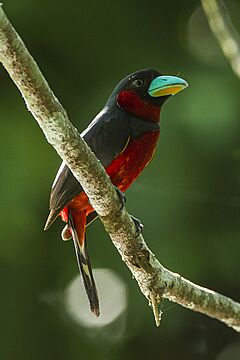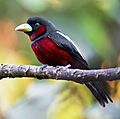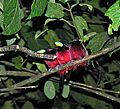Black-and-red broadbill facts for kids
Quick facts for kids Black-and-red broadbill |
|
|---|---|
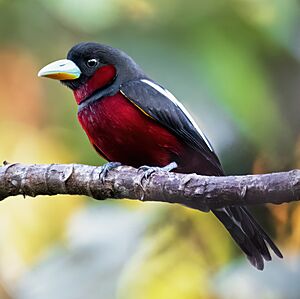 |
|
| Conservation status | |
| Scientific classification | |
| Genus: |
Cymbirhynchus
|
| Species: |
macrorhynchos
|
 |
|
| Black-and-red broadbill distribution | |
| Synonyms | |
The black-and-red broadbill (Cymbirhynchus macrorhynchos) is a unique and colorful bird. It belongs to the broadbill family, called Eurylaimidae. This bird is the only species in its group, known as the Cymbirhynchus genus.
This large bird is easy to spot. It has a bright maroon belly and black feathers on its back. A maroon band wraps around its neck. Its wings have white stripes. One of its most striking features is its big, two-toned bill. The top part is blue, and the bottom is yellow.
Female broadbills are a bit smaller than males. No other bird in its home range looks quite like it. However, the black-and-yellow broadbill makes a similar sound.
You can find this bird in many countries. These include Brunei, Cambodia, Indonesia, Laos, Malaysia, Myanmar, Singapore, Thailand, and Vietnam. It likes to live in forests near rivers, especially in low areas. It can also live in places where the forest has been changed by humans. This includes new forest growth or damaged areas near rivers.
The black-and-red broadbill mostly eats insects. But it also enjoys water creatures. These include snails, fish, and crustaceans (like crabs). Sometimes, it accidentally eats leaves and seeds too.
They usually build nests during the dry season. Their nests are large and easy to see. They often hang over water. Both male and female birds help build the nest. They use vines, moss, and other plant materials. They lay two or three eggs, sometimes four. Both parents take turns sitting on the eggs.
The International Union for Conservation of Nature (IUCN) says this bird is a "least-concern species." This means it's not currently in danger. It lives in a wide area, and its numbers are not dropping quickly. However, in some places, its population has gone down. This is due to deforestation (cutting down forests). It is also threatened by trapping for the songbird trade and hunting.
Contents
What's in a Name?
The black-and-red broadbill got its first scientific name, Todus macrorhynchos, in 1788. A German scientist named Johann Friedrich Gmelin gave it this name. He based it on a bird from Borneo. An English scientist, John Latham, had described it earlier.
The name Cymbirhynchus comes from Greek words. Kumbē can mean "small boat" or "an unknown bird." Rhunkhos means "bill." So, the name might mean "boat-billed bird." The species name macrorhynchos also comes from Greek. It means "long-billed."
The official English name is "black-and-red broadbill." But people also call it the "black-red broadbill." In other languages, it has different names. For example, in Thai, it's called Nok Phaya Paak Kwaang thong daeng.
This bird is the only one in its group, Cymbirhynchus. It belongs to the broadbill family, Eurylaimidae. This family has ten tropical bird species. They all live in Southeast Asia. Scientists believe its closest relative is the silver-breasted broadbill.
Different Types of Broadbills
There are four recognized types, or subspecies, of the black-and-red broadbill. These types look a little different depending on where they live. For example, birds tend to get bigger from north to south. Also, the amount of white on their tails changes.
- C. m. macrorhynchos: This is the main type. It lives on Borneo, Sumatra, and nearby islands.
- C. m. affinis: Also called the Irrawaddy broadbill. It's found in southern Myanmar. This type is smaller and has lighter red colors. It also has small white spots on its wings and tail. Some scientists think it might be a separate species.
- C. m. malaccensis: This type lives in the Malay Peninsula. It used to be found in Singapore too. It's a bit smaller than the main type. Its red feathers are also a bit paler.
- C. m. siamensis: You can find this type from southern Myanmar to northern Malaysia and southern Thailand. It also lives in Cambodia, southern Laos, and southern Vietnam. It looks a lot like malaccensis but is smaller. It also has shorter wings and more white on its tail feathers.
What Does It Look Like?
The black-and-red broadbill is a large bird. Its unique colors make it easy to identify. An adult bird is usually about 21–24 centimeters (8.3–9.4 inches) long. It weighs between 51–65 grams (1.8–2.3 ounces).
Both male and female birds look similar. But females are slightly smaller. Adults have black heads and a black band across their chest. Their upper bodies are greenish-black. They have a maroon half-collar and bright maroon feathers on their lower back and tail.
The feathers on their shoulders have white edges. This forms a white line when their wings are closed. The bend of their wing has a thin orange line. Their tail is black with some white.
Their bill is very colorful. The top part is bright turquoise-blue. The bottom part is yellow-orange with a blue tip and edges. Their eyes are a bright emerald green. Their feet are bright blue, sometimes with a purple tint.
Young birds look a bit like adults. But their upper wings are browner. They have white spots on their wing feathers. Their eyes are purple. Very young birds have duller colors. Their upper parts are sooty brown. They have maroon patches on their lower back and tail. Their bills are dark blue-grey. Their eyes are bronze. Their feet are dull blue-grey.
The bright red color of this bird comes from a special natural pigment. This pigment is also found in other red broadbills.
One of the most amazing things about this bird is its large, boat-shaped bill. Scientists think this wide bill helped broadbills eat insects. It also has a large, fleshy tongue. This helps it move food around inside its beak.
Bird Sounds
The black-and-red broadbill is not as noisy as other broadbills. It often stays quiet. Its calls are also softer and quieter than most.
They make rising 'weeet' sounds. These are like the sounds of the black-and-yellow broadbill. But they are shorter, slower, and softer. Its call to attract a mate might be a rising, cicada-like trill. When it's alarmed, it makes quick 'pip' notes.
A soft, repeated 'wiark' sound has been heard between a pair building a nest. Other sounds include a steady 'tyook'. It also makes a rough 'ka-ka-kraar-kraar'. Sometimes, it makes a sharp 'peek-peek-peek'. It can also make churring sounds and pretty whistles. Some people have even heard it make snarls like a puma! In Laos, people often hear a series of quick 'parnk' notes. These sound like the wingbeats of a large wreathed hornbill.
Where Do They Live?
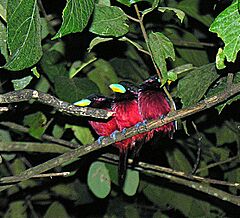
The black-and-red broadbill lives in many countries in Southeast Asia. These include Brunei, Cambodia, Indonesia, Laos, Malaysia, Myanmar, Singapore, Thailand, and Vietnam. In some parts of Thailand, it has disappeared. It was common in Singapore until the 1940s. Then it wasn't seen again until 2004, and then 2020.
It mostly lives in forests along rivers. These areas are usually below 300 meters (980 feet) in height. But sometimes, you can find it up to 900 meters (3,000 feet). In areas closer to the coast, it lives in swamps with screw-palms near mangroves.
In places where a lot of land has been changed, it lives in rubber plantations and coconut groves. These places have water channels. It has also been seen in peat swamp forests. But it rarely goes into dense, closed forests.
This bird can adapt well to changed habitats. It can live in secondary forests that still have some tall trees. It also lives in areas with scattered forest clumps in pastureland. It even lives in very damaged areas along rivers.
How Do They Live?
Black-and-red broadbills are usually seen alone, in pairs, or in family groups. They are known to roost (sleep) together in small groups. Sometimes, several adults call out together. This might happen when they are defending their territory. These birds usually live for about three years.
Building a Home

Broadbills usually build their nests during the driest months of the year. This is from January to August in Malaysia. In Myanmar, it's from late February to June. In Thailand, it's May and June. In Borneo, it's December to August. And in Sumatra, it's March to June. Nests have also been seen in June in Vietnam and May in Laos. These times are usually near the end of the local dry seasons.
Their nests are easy to spot. They usually hang over water, especially fast-moving water. They are often built over forest pools, rivers, and streams. Less often, they are over coastal areas or man-made ditches. Sometimes, nests are built far from water, or even over roads. This might be because they need to find food near water for their mates or young.
Both male and female birds build the nest. It usually takes about 11 days. But sometimes it can take up to 49 days! In some cases, 1–2 helper birds also assist with building.
Their nests are smaller than those of other broadbills. They are 25–46 cm (9.8–18.1 inches) tall (not counting the hanging part). They are 14.7–31.0 cm (5.8–12.2 inches) wide. They weigh 59.7–181.9 grams (2.1–6.4 ounces). The entrance hole is 3.8–6.5 cm (1.5–2.6 inches) wide. The inside chamber is 9.5–13.0 cm (3.7–5.1 inches) tall and 6–9 cm (2.4–3.5 inches) wide.
The nests look like ragged, bag-shaped, or pear-shaped structures. They are made from tightly woven grasses, vines, sticks, bark, leaves, and moss. The inside is often lined with soft green leaves. The side entrance has a roof made of grass or fibers. Nests are usually attached to thin, flexible, and spiky branches.
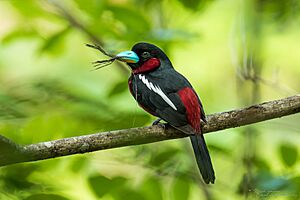
The black-and-red broadbill lays 2–3 eggs at a time. Sometimes, there's a fourth, smaller egg. The eggs are 25.0–29.3 × 18.2–20.7 mm (0.98–1.15 × 0.72–0.81 inches) in size. They are whitish to pinkish. Most eggs have dense reddish-brown spots. These spots are thicker at the larger end. Some eggs have only a few brick-red spots. A few have sparse black spots.
Eggs are laid one day apart. Both parents sit on the eggs. This incubation takes 21 days. After hatching, the young birds are helpless. Both parents care for them for about 17 days. Dangers to young birds include forest fires, predators, and human disturbance.
What Do They Eat?
The black-and-red broadbill mainly eats insects. It feeds on many kinds of insects. These include ants, beetles, crickets, grasshoppers, caterpillars, and bugs.
It also eats many creatures found in rivers. These include snails, crustaceans (like small crabs), and small fish. It has been seen eating seeds and leaves. But these might have been eaten by accident.
They find food by grabbing prey from the ground or the water's edge. They have also been seen catching flying moths above streams.
Who Are Their Enemies?
Studies have shown that black-and-red broadbills can have tiny parasites. For example, a study in Vietnam found that all broadbills examined had a type of chewing louse. These lice usually live on other birds called bulbuls. So, this was a case of the lice switching hosts.
Their nests can also have tiny mites. Potential predators of the black-and-red broadbill include birds of prey, civets, monkeys, snakes, and monitor lizards.
How Are They Doing?
The exact number of black-and-red broadbills is not known. Their population is thought to be decreasing. However, they are not considered an endangered species. The International Union for Conservation of Nature (IUCN) lists them as "least-concern." This is because they live in a very large area.
The Irrawaddy broadbill, which some consider a separate species, is also "least-concern." This is true even though its population is decreasing.
This bird lives in many protected areas. In these places, their numbers are quite stable. However, in some areas, like Thailand, their numbers have dropped a lot. This is mainly because of deforestation (forest clearing). But they are still common where good habitat remains.
They are common in the lowlands of Borneo. But they are rare in higher areas and dense forests. In Sumatra, they used to be the most common broadbill. Now, they are very rare, even though they live in a large area. It's generally hard to find them in Indochina. But they are common in suitable habitats. They are also common in Myanmar where good habitat exists. However, there aren't many recent records to confirm this.
Other dangers to the black-and-red broadbill include trapping for the songbird trade. They are also threatened by hunting.
Images for kids



